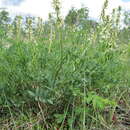Comprehensive Description
provided by North American Flora
Atelophragma williamsii Rydb. Bull. Torrey Club 55: 132. 1928.
Astragalus Williamsii Rydb. Bull. N. Y. Bot. Gard. 2: 175. 1901. Astragalus Gormaui Wight; M. E. Jones, Rev. Astrag. 132. 1923.
A perennial, with a cespitose caudex; stems ascending or erect, 2-4 dm. high, more or less 4-angled, glabrous, light-green, in age straw-colored; leaves 5-10 cm. long, ascending; stipules ovate or lanceolate, 3-6 mm. long, free; leaflets 9-11, oval to linear, 1.5-3.5 cm. long, 4-12 mm. wide, obtuse, or the broader ones retuse, perfectly glabrous; peduncles 1-1.5 dm. long; racemes at first short, in fruit about 1 dm. long; bracts oblong, obtuse, straw-colored, 3 mm. long; pedicels 1-2 mm. long; calyx black-hairy, the tube about 3 mm. long, the teeth less than 1 mm. long, deltoid, obtuse; corolla ochroleucous, with a purplish-tipped keel; banner about 1 cm. long, narrowly obovate, slightly arched, retuse at the apex; wings shorter, the blade longer than the claw, with a long reflexed auricle; keel-petals still shorter, the blade obliquely obovate, stronglyarched and rounded at the apex; pod erect, subsessile, the body 10-14 mm. long, 4 mm. wide, nearly terete, strigulose with black and white hairs or in age glabrate, deeply sulcate on the lower suture, the septum about 1 mm. wide, becoming narrower upwards and extending onlyhalf the length of the pod; seeds obliquely reniform, brownish-black.
Type locality: Big Salmon, Yukon.
Distribution: Yukon and Alaska.
- bibliographic citation
- Per Axel Rydberg. 1919. (ROSALES); FABACEAE; PSORALEAE. North American flora. vol 24(1). New York Botanical Garden, New York, NY
Physical Description
provided by USDA PLANTS text
Perennial, Herbs, Stems woody below, or from woody crown or caudex, Taproot present, Nodules present, Stems erect or ascending, Stems less than 1 m tall, Stems solid, Stems or young twigs sparsely to densely hairy, Leaves alternate, Leaves petiolate, Stipules conspicuous, Stipules membranous or chartaceous, Stipules persistent, Stipules connate to each other, forming a tuber or sheath, Leaves compound, Leaves odd pinnate, Leaf or leaflet margins entire, Leaflets o pposite, Leaflets 10-many, Leaves hairy on one or both surfaces, Inflorescences racemes, Inflorescence axillary, Bracts very small, absent or caducous, Flowers zygomorphic, Calyx 5-lobed, Calyx hairy, Petals separate, Corolla papilionaceous, Petals clawed, Petals ochroleucous, cream colored, Petals orange or yellow, Banner petal narrow or oblanceolate, Wing petals narrow, oblanceolate to oblong, Wing tips obtuse or rounded, Keel petals auriculate, spurred, or gibbous, Keel tips obtuse or rounded, not beaked, Stamens 9-10, Stamens diadelphous, 9 united, 1 free, Filaments glabrous, Style terete, Style persistent in fruit, Fruit a legume, Fruit stipitate, Fruit freely dehiscent, Fruit oblong or ellipsoidal, Fruit rugose wrinkled or reticulate, Fruit exserted from calyx, Fruit beaked, Fruit glabrous or glabrate, Fruit hairy, Fruit 3-10 seeded, Fruit 11-many seeded, Seeds cordiform, mit-shaped, notched at one end, Seed surface smooth, Seeds olive, brown, or black.

